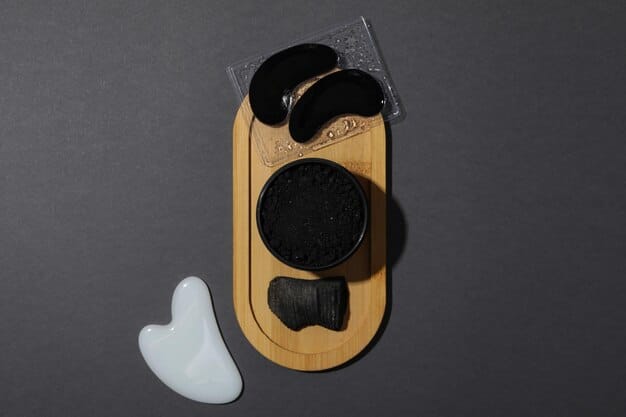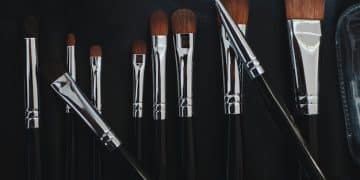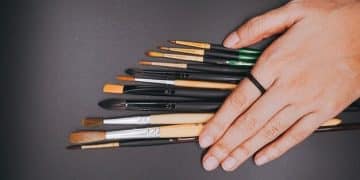Facial cleansing brushes: are they worth it for men’s skin?

While facial cleansing brushes can offer deeper exfoliation and promote a more thorough clean, their necessity and benefits for men’s skin depend heavily on individual skin type, concerns like oiliness or breakouts, and proper usage to avoid irritation, balancing potential advantages against the risk of overuse.
For many men, the daily skincare routine has traditionally been quite simple: a quick wash, perhaps some aftershave, and off you go. However, as the world of skincare evolves, so too do the tools available, and one product that has gained significant traction is the facial cleansing brush. But are facial cleansing brushes: are they worth the hype for men’s skin?
The basics of men’s skin and cleansing
Understanding the unique characteristics of men’s skin is the foundational step to assessing the utility of any skincare tool, including cleansing brushes. Men’s skin generally differs from women’s in several key ways, primarily due to hormonal influences, particularly testosterone. These differences dictate how skin behaves and, consequently, what kind of care it requires.
One of the most notable distinctions is thickness. Men’s skin tends to be about 20% thicker than women’s, a factor that contributes to its perceived toughness. This increased thickness is often accompanied by a denser collagen network, which can make men’s skin appear firmer and show signs of aging, such as wrinkles, at a later stage, though when they do appear, they can be deeper. The added density means it might withstand more vigorous cleansing methods than more delicate skin.
Oil production and pore size
Another crucial difference lies in sebum production. Men’s sebaceous glands are typically more active, leading to higher oil production. This increased oiliness often translates to larger, more visible pores and a greater propensity for issues like blackheads, whiteheads, and acne. Regular and thorough cleansing becomes paramount to manage this excess sebum, prevent clogged pores, and maintain a clear complexion.
- Thicker Skin: Approximately 20% thicker, making it potentially more resilient.
- Higher Sebum Production: Leads to oilier skin and larger pores.
- More Collagen: Results in firmer skin, but deeper wrinkles when they appear.
- Daily Shaving Impact: Causes micro-traumas and can lead to irritation and ingrown hairs.
Furthermore, daily shaving is a unique challenge for men’s skin. The repeated action of a razor, regardless of its sharpness or the quality of shaving cream, causes microscopic abrasions and stress to the skin barrier. This can lead to irritation, redness, and the formation of ingrown hairs – a common complaint that requires diligent cleansing and exfoliation to mitigate. The practice of shaving also impacts skin sensitivity, potentially making it more reactive to harsh products or aggressive cleansing.
Given these specific characteristics—thicker, oilier, and frequently irritated by shaving—the appeal of a tool designed for deep cleansing and exfoliation, like a facial brush, becomes evident. It promises to tackle concerns that are often more pronounced in men, offering a potentially more effective solution than manual washing alone.
The science behind cleansing brushes
To truly evaluate whether facial cleansing brushes are worth the investment for men, it’s essential to look beyond marketing claims and delve into the scientific principles that underscore their operation and purported benefits. These devices, whether vibrating, rotating, or sonic, aim to enhance the cleansing process in ways that manual washing typically cannot achieve.
At their core, facial cleansing brushes work by providing a more thorough and consistent mechanical exfoliation and deep cleaning than fingers alone. The bristles, often made of nylon or silicone, gently or vigorously (depending on the brush type and setting) dislodge dirt, oil, makeup, and dead skin cells from the skin’s surface and within pores. This action contributes significantly to preventing clogged pores, which are a precursor to blackheads, whiteheads, and acne breakouts.
Types of brushes and their mechanisms
- Rotating Brushes: These have a brush head that spins, offering a more abrasive, scrub-like action. They are effective for deep cleansing but can be too harsh for sensitive or acne-prone skin, potentially causing irritation or micro-tears.
- Vibrating/Sonic Brushes: These brushes use high-frequency vibrations to produce sonic waves that effectively loosen dirt and oil without direct rotation. This gentler approach is less abrasive and often preferred for all skin types, including sensitive ones, as it provides a deep clean with minimal mechanical friction.
- Silicone Brushes: These don’t rely on bristles but rather on soft, antimicrobial silicone nubs. They are known for being hygienic, gentle, and durable, offering a softer exfoliation that’s suitable for daily use and less likely to harbor bacteria.
The exfoliating action of these brushes is not merely superficial. By removing the uppermost layer of dead skin cells, they promote cellular turnover, which is the natural process of replacing old skin cells with new ones. This accelerated turnover can lead to a brighter, smoother complexion and can also improve the absorption of subsequent skincare products, such as serums and moisturizers, allowing them to penetrate deeper and work more effectively.
Moreover, the stimulation provided by the brush can enhance blood circulation to the skin’s surface. Increased blood flow brings more oxygen and nutrients to the skin cells, potentially contributing to a healthier, more vibrant appearance. Some studies suggest that the regular use of cleansing brushes can also lead to a reduction in the appearance of pore size, though this is often a result of pores being more thoroughly cleaned and thus appearing less prominent, rather than a physical reduction in their size.
However, it’s crucial to acknowledge the potential downsides. Over-exfoliation or excessive pressure can compromise the skin’s natural barrier, leading to dryness, redness, irritation, and increased sensitivity. Bacteria can also accumulate on brush heads if not cleaned properly, potentially leading to breakouts. Therefore, understanding the science not only highlights the benefits but also underscores the importance of proper usage and maintenance.

Benefits for men’s skin: where the hype meets reality
The market for men’s grooming products has exploded, and with it, the claims made by various tools and formulations. When it comes to facial cleansing brushes, the advertised benefits for men’s skin are numerous, but it’s important to discern which of these are truly substantiated and offer tangible improvements.
One of the most compelling advantages of using a facial cleansing brush, particularly for men, is the promise of a deeper clean. As discussed, men’s skin tends to be oilier and has larger pores, making it more prone to congestion. Manual washing, even with a quality face wash, often falls short in thoroughly dislodging all the dirt, oil, and grime that accumulates throughout the day. A cleansing brush, with its oscillating or vibrating action, can penetrate more effectively into pores, offering a level of cleanliness that can visibly improve skin clarity and reduce the likelihood of breakouts.
Exfoliation and ingrown hairs
Beyond basic cleaning, exfoliation is a significant benefit. Regular exfoliation is vital for removing dead skin cells that can dull the complexion and contribute to clogged pores and ingrown hairs. For men who shave daily, ingrown hairs are a persistent nuisance. The gentle yet consistent exfoliation provided by a cleansing brush can help lift trapped hairs and prevent new ones from forming, leading to a smoother, less irritated shave area. This improved skin texture also enhances the appearance, making skin feel softer and look more refined.
The regular use of a cleansing brush can also improve the efficacy of other skincare products. By clearing away the barrier of dead skin cells and impurities, the skin becomes more receptive to serums, moisturizers, and other treatments. This means that active ingredients can penetrate deeper and deliver their intended benefits more effectively, potentially leading to better hydration, reduced fine lines, and overall healthier skin.
- Deeper Clean: More effectively removes dirt, oil, and impurities from pores.
- Reduced Ingrown Hairs: Exfoliation helps free trapped hairs and prevents new ones.
- Improved Skin Texture: Leads to a smoother, softer complexion.
- Enhanced Product Absorption: Allows serums and moisturizers to work better.
- Better Shave Prep: Prepares the skin for a closer, less irritating shave.
Another often-cited benefit is the subtle massage effect. The vibrations or rotations of the brush can stimulate blood flow to the skin, which brings oxygen and nutrients to the surface, potentially contributing to a more radiant and healthy-looking complexion. While this effect is often subtle, consistent use can contribute to general skin vitality.
Ultimately, for men battling persistent oiliness, frequent breakouts, dull skin, or ingrown hairs, a facial cleansing brush can be a valuable addition to their regimen. It’s about achieving a level of clean and exfoliation that supports healthier skin and addresses specific concerns more effectively than traditional methods.
Potential drawbacks and how to mitigate them
While facial cleansing brushes offer numerous benefits, it’s equally important to consider their potential drawbacks. Like any powerful skincare tool, improper use or unsuitable choice can lead to adverse effects, especially on men’s often more resilient but still sensitive skin. Understanding these issues and knowing how to mitigate them is crucial for a positive experience.
One of the most common pitfalls is over-exfoliation. Because cleansing brushes provide mechanical exfoliation, using them too frequently or with too much pressure can strip the skin of its natural oils, leading to a compromised skin barrier. This can result in dryness, redness, flakiness, heightened sensitivity, and even micro-tears in the skin. For men, whose skin can be subjected to the daily stress of shaving, adding excessive exfoliation can exacerbate irritation.
Irritation and hygiene concerns
Another concern is irritation. If a brush head is too stiff, or if one uses an abrasive cleanser in conjunction with a brush, the skin can become inflamed. This is particularly relevant for men with sensitive skin, rosacea, or active acne, as the mechanical action can worsen these conditions. Choosing the right type of brush (e.g., a soft silicone brush over a rotating bristle brush) and a gentle cleanser is paramount.
Hygiene is also a significant consideration. Bristle brushes, in particular, can harbor bacteria if not cleaned thoroughly and regularly. A dirty brush can transfer bacteria to the face, potentially leading to breakouts and skin infections, negating any cleansing benefits. This risk is lower with silicone brushes, which are naturally antimicrobial and easier to clean.
- Over-exfoliation: Leads to dryness, redness, and a compromised skin barrier.
- Irritation: Can aggravate sensitive skin, rosacea, or active acne.
- Bacterial Growth: Dirty brush heads can harbor bacteria, leading to breakouts.
- Cost: Initial investment and replacement heads can be expensive.
- Requires Discipline: Consistent, proper use is necessary to see benefits.
The initial cost of a quality facial cleansing brush can be a deterrent for some. Beyond the device itself, replacement brush heads often need to be purchased every few months, adding to the ongoing expense. For someone unsure of the benefits, this can represent a significant investment.
Mitigating these drawbacks involves several key strategies: First, start slowly. Begin by using the brush 2-3 times a week, observing how your skin reacts, and gradually increasing frequency if your skin tolerates it. Second, choose the right brush for your skin type; silicone brushes or sonic brushes with soft bristles are generally safer bets for most men. Third, always use a gentle, non-foaming cleanser with your brush. Avoid harsh scrubs or cleansers containing strong active ingredients when using a brush, as this can lead to over-exfoliation.
Finally, meticulous hygiene is non-negotiable. Rinse your brush head thoroughly after each use and allow it to air dry. For bristle brushes, consider using an antibacterial soap or a specialized brush cleaner weekly, and replace brush heads as recommended by the manufacturer. By being mindful of these points, men can largely avoid the common pitfalls and safely incorporate a cleansing brush into their routine.
Choosing the right brush for your skin type
Selecting the appropriate facial cleansing brush is arguably the most critical step in determining whether it will be a beneficial addition to your skincare routine. With a burgeoning market offering a variety of technologies and designs, knowing which brush aligns best with your specific skin type and concerns is essential to maximize benefits and minimize potential harm.
For men with oily or combination skin, which is a common profile due to higher sebum production, a brush designed for deeper cleaning and exfoliation might seem ideal. However, even with oilier skin, it’s crucial to avoid overly aggressive options that could strip the skin and trigger even more oil production as a rebound effect. Sonic brushes with soft silicone nubs or very gentle bristles are often excellent choices. They provide effective exfoliation and deep cleaning without being overly abrasive, which can still cause irritation on oily, yet susceptible, skin.
Considerations for sensitive or acne-prone skin
Men with sensitive skin, prone to redness, irritation, or conditions like rosacea, must exercise extreme caution. For these individuals, harsh mechanical exfoliation can be highly detrimental. A soft silicone brush is typically the safest bet. Silicone is non-porous, hypoallergenic, and naturally resistant to bacteria, making it exceptionally gentle. The vibrations of a sonic silicone brush can effectively cleanse without the friction associated with traditional bristle brushes, minimizing the risk of irritation. The same gentleness applies to acne-prone skin; while deep cleansing is necessary, aggressive scrubbing can burst active pimples, spreading bacteria and worsening breakouts.
For men with normal skin, who may experience fewer specific concerns but still want to improve overall skin health and clarity, there’s more flexibility. Both sonic bristle brushes with fine, soft bristles and silicone brushes can be suitable. The choice often comes down to personal preference regarding texture and maintenance. Sonic brushes traditionally offer a wider range of speed settings, allowing for customization based on how well the skin tolerates the cleansing action.
- Oily/Combination Skin: Sonic brushes with soft silicone or gentle bristles, to avoid stripping.
- Sensitive Skin: Soft silicone brushes exclusively, due to their non-abrasive nature.
- Acne-Prone Skin: Gentle silicone or soft sonic brushes, to prevent aggravating breakouts.
- Normal Skin: Both gentle sonic bristle brushes or silicone brushes are suitable.
- Key Factor: Prioritize gentleness and adjust frequency based on skin tolerance.
Beyond skin type, consider practicality. Rechargeable brushes offer convenience, and waterproof designs are essential for use in the shower. Battery life, ease of cleaning, and the availability of replacement heads also factor into the long-term usability and cost-effectiveness of the device. Ultimately, the right brush for a man’s skin isn’t necessarily the most powerful or expensive one, but rather the one that provides effective cleansing and exfoliation without compromising the skin’s health and integrity.
Integrating a facial cleansing brush into your routine
Once you’ve decided that a facial cleansing brush is right for you and have selected the appropriate model, the next crucial step is seamlessly integrating it into your existing skincare routine. Proper integration ensures you reap the benefits without encountering common pitfalls like over-exfoliation or irritation, especially important for men’s skin that might also deal with the impact of daily shaving.
The general recommendation is to use a facial cleansing brush after removing any heavy dirt or grime, usually in the evening. This ensures the brush can focus on deeper cleansing and exfoliation without simply pushing surface impurities around. For most men, incorporating it into their evening shower or before bedtime makes practical sense. However, for those with very oily skin or who engage in strenuous physical activity, a morning use might also be beneficial, but always with caution to avoid overuse.
Frequency and technique
Start slowly. Even if your skin isn’t overtly sensitive, introducing a new, more intensive cleansing method requires a period of adjustment. Begin by using the brush 2-3 times a week. Observe how your skin responds over a couple of weeks. If your skin feels comfortable, not dry, red, or irritated, you can gradually increase frequency to daily or every other day, depending on your skin type and concerns. Men with sensitive or dry skin may find that 2-3 times a week is their optimal frequency, while those with very oily skin might tolerate daily use.
Technique matters significantly. Apply a small amount of a gentle, non-foaming cleanser to your damp face or directly to the wet brush head. Turn on the brush and gently move it in small, circular motions across your face. Avoid pressing too hard; the brush is designed to do the work. Focus on areas prone to oiliness, such as the T-zone (forehead, nose, chin). Spend 15-20 seconds on each section of your face, typically limiting total usage to no more than 60-90 seconds for the entire face.
- Timing: Use once daily, preferably in the evening, after initial cleanse.
- Start Slow: Begin 2-3 times a week, increasing gradually based on skin tolerance.
- Gentle Cleanser: Pair with a mild, non-foaming face wash.
- Light Pressure: Let the brush do the work; do not press hard.
- Post-Cleansing: Follow immediately with toner, serum, and moisturizer.
After cleansing with the brush, rinse your face thoroughly with lukewarm water. Pat your skin dry with a clean, soft towel. This is the optimal time to apply your post-cleansing products: a toner to balance skin pH, followed by any serums (e.g., hyaluronic acid for hydration, niacinamide for oil control), and finally, a good quality moisturizer. The freshly exfoliated skin will be more receptive to these ingredients, enhancing their effectiveness.
Equally important is the maintenance of the brush itself. Rinse the brush head thoroughly after each use to remove all cleanser and debris. Allow it to air dry in an upright position. For bristle brushes, consider weekly cleaning with an antibacterial soap and replacing the brush head every 3-4 months, or as recommended by the manufacturer. Silicone brushes are generally more hygienic and easier to clean, but still benefit from regular rinsing. Proper integration means not just using the tool, but also caring for it diligently.

Beyond cleansing: long-term skin health for men
While a facial cleansing brush can be a valuable asset in a man’s grooming arsenal, it’s crucial to understand that it is just one component of a holistic approach to long-term skin health. Achieving and maintaining healthy skin goes far beyond cleansing, encompassing a broader spectrum of habits, products, and lifestyle choices. For men, this means adopting a comprehensive mindset towards skincare, moving past the notion that a single product or tool is a magic bullet.
Good skincare starts with consistency. Regardless of the products or tools chosen, sporadic use yields minimal results. A consistent daily and weekly routine, tailored to specific skin needs, is paramount. This includes not just cleansing, but also moisturizing daily to maintain the skin barrier and prevent dryness, and critically, using sun protection. Sunscreen is perhaps the single most impactful product for long-term skin health, preventing premature aging, sunspots, and significantly reducing the risk of skin cancer. Many men overlook this essential step, assuming it’s only necessary on beach days.
Nutrition, hydration, and lifestyle impacts
What goes into your body profoundly impacts your skin. A balanced diet rich in fruits, vegetables, lean proteins, and healthy fats provides the essential vitamins, minerals, and antioxidants needed for skin repair and regeneration. Processed foods, excessive sugar, and unhealthy fats can contribute to inflammation, which can manifest as breakouts or dullness. Similarly, adequate hydration is non-negotiable; drinking enough water throughout the day helps maintain skin elasticity and a healthy glow from within.
Stress management and sufficient sleep are also vital, though often underestimated, components of skin health. Chronic stress can trigger hormonal imbalances that exacerbate skin conditions like acne or eczema. Lack of sleep impairs the skin’s ability to repair itself overnight, leading to a tired, dull appearance and potentially accelerating the aging process. Prioritizing these aspects of lifestyle can have a profound positive impact on skin clarity and vitality.
- Consistent Routine: Daily cleansing, moisturizing, and sun protection.
- Balanced Diet: Rich in fruits, vegetables, and lean proteins for essential nutrients.
- Adequate Hydration: Drink plenty of water for skin elasticity and glow.
- Stress Management: Reduces hormonal imbalances that affect skin.
- Sufficient Sleep: Allows skin to repair and rejuvenate overnight.
- Professional Guidance: Consult a dermatologist for persistent concerns.
Finally, men should consider professional guidance for persistent skin concerns. A dermatologist can provide a deeper understanding of specific skin conditions, recommend targeted treatments, and offer personalized advice that a general at-home routine might miss. For issues like severe acne, persistent sensitivity, or unusual growths, professional consultation is invaluable.
In essence, a facial cleansing brush enhances the cleansing step, but it is one piece of a much larger puzzle. For long-term skin health, men must embrace a holistic approach that integrates mindful product selection, consistent routines, healthy lifestyle choices, and when necessary, expert advice. This comprehensive strategy is what truly leads to resilient, healthy, and revitalized skin.
| Key Point | Brief Description |
|---|---|
| 🧼 Deeper Clean | Brushes effectively remove dirt and oil from pores compared to manual washing. |
| 🧔 Ingrown Hair Prevention | Exfoliation helps lift trapped hairs and minimize new ingrown hairs, especially for shavers. |
| 🚨 Risk of Over-Exfoliation | Improper use can lead to irritation, dryness, or a compromised skin barrier. |
| 🔄 Choose Wisely | Silicone or gentle sonic brushes are ideal for sensitive or acne-prone skin. |
Frequently asked questions about facial cleansing brushes for men
Whether a facial cleansing brush is safe for daily use on men’s skin largely depends on individual skin type and the brush’s intensity. For men with oily or normal skin and a gentle, sonic or silicone brush, daily use may be acceptable. However, those with sensitive, dry, or acne-prone skin should start with 2-3 times a week to avoid over-exfoliation and irritation, gradually increasing frequency if well-tolerated.
Yes, facial cleansing brushes can be particularly effective in helping to prevent and treat ingrown hairs for men. Their exfoliating action helps to lift trapped hairs and remove dead skin cells that can contribute to hairs growing inwards. Regular, gentle use before shaving can prepare the skin, leading to a smoother shave and fewer ingrown hairs, improving overall skin texture and appearance.
For men with sensitive skin, a soft silicone facial cleansing brush is generally the best choice. Silicone is non-abrasive, hypoallergenic, and naturally antimicrobial, reducing the risk of irritation and bacterial buildup. These brushes often use sonic pulsations rather than harsh rotations, providing a deep yet gentle clean that avoids aggravating sensitive skin, redness, or conditions like rosacea, ensuring comfort and efficacy.
A cleansing brush improves product absorption by effectively exfoliating the skin. By removing the superficial layer of dead skin cells and impurities, it creates a smoother, more permeable surface. This allows subsequent skincare products like serums and moisturizers to penetrate deeper into the skin, rather than sitting on the surface. Consequently, active ingredients can be more effective, leading to better hydration and overall skin health.
In most cases, if you regularly use a facial cleansing brush, you may not need a separate physical exfoliator. Cleansing brushes provide mechanical exfoliation that is sufficient for most men’s skin. Over-exfoliation from using both can lead to irritation and damage to the skin barrier. However, a chemical exfoliator (like an AHA or BHA toner) might still be beneficial for specific concerns like acne or texture, used judiciously.
Conclusion
The journey through the world of facial cleansing brushes for men reveals a nuanced landscape where hype undeniably meets reality. For many men, particularly those battling oiliness, breakouts, coarse skin, or persistent ingrown hairs, these devices offer a tangible upgrade to their cleansing routine, providing a deeper clean and more effective exfoliation than manual washing. They can significantly improve skin texture, reduce pore visibility, and enhance the efficacy of other skincare products. However, the benefits are directly tied to informed choices and proper usage. Over-exfoliation, irritation, and hygiene issues are genuine concerns that underscore the importance of selecting the right brush for one’s skin type, using it with a gentle cleanser, and maintaining it diligently. Ultimately, a facial cleansing brush is not a singular solution but a valuable tool that, when integrated thoughtfully into a comprehensive and consistent skincare regimen, can genuinely contribute to healthier, clearer, and more revitalized men’s skin, making it a worthy consideration for those seeking to elevate their grooming game.





